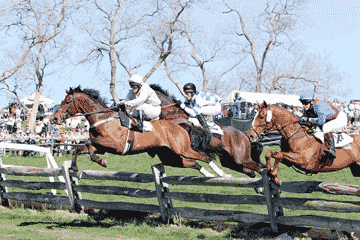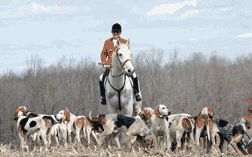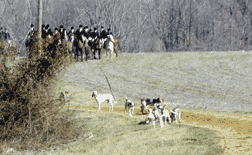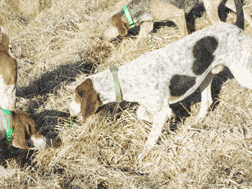There’s More Than the Tailgate to the Marlborough Hunt Races
These horse races are brought to you by a fox and the hounds
by Aubree Stafford
Maryland is for horses — and the annual Marlborough Hunt Races confirm that the bumper-sticker saying rings true in Southern Anne Arundel County. This year, cars, trucks and SUVs will line Wayson Road on April 8, filing onto Roedown Farm in Davidsonville like ants marching to a picnic blanket. On every other day of the year, horses wander over the rolling hills traced with faded brown fencing. Red barns trimmed in pink spot the landscape. On this spring Sunday, the 150-acre Thoroughbred racehorse farm transforms into a festival of bright hats and themed tailgates.
On many race days past, revelers braved chilly temperatures and muck up to their shins to take part in this rite of Maryland horse tradition. Last year, blue, sunny skies brought a record crowd — over 5,000 people — to the farm. We can’t predict the weather for this year’s race, but rain or shine the tradition will continue.
Tailgaters socialize, sip spirits and make merry. Some spectators, often members of the local horse community, keep track of which horse and rider wins each race. Other party-goers cheer when they catch a glimpse of a speedy horse — and return to their conversation or grab another hors d’oeuvre. Sure, everyone knows the reason for the party is the race, but many barely glance at horse and rider as they speed past. Fantastical fruit and cheese displays topped with caviar might take center stage at the tailgate feast, but the real star of the show is the steeplechase.
The Roots of Roedown
Here’s what preoccupied tailgaters are missing.
In the afternoon’s last race, hunters bedecked in the coats and breeches of formal hunting attire speed over the flat as fast as their horse can go on Foxhunters Relay Race Challenge. Sunlight glistens off the riders’ shiny, black boots as they bolt back to their team to pass the baton to the next rider.
On this course, unexpected jumps don’t appear; it’s an all-out sprint. But on the foxhunting field where it all began, horse and rider must soar over anything in their way.
Steeplechase historians disagree over whether the sport originated in England or Ireland, but they do agree that it began as competition among foxhunters. During a foxhunt, horse and rider track a pack of headlong hounds on the scent of a fox. In the course of the chase, they traverse unexpected terrain, scaling all the hurdles nature imagines to stay on the fox’s scent.
Testing their abilities, early hunters challenged each other to races across the countryside. Church steeples, universally visible in the old country, served as destination points; hence the sport’s name.
Over the years, the riders formalized the race as an organized jumping course. On a flat track, speed wins the race. In steeplechase, horse and rider must bound over jumps while keeping up the pace.
“To challenge their hunt horses, hunt clubs began hosting races,” explains Valerie Vizcarrando, horse trainer, instructor and staffer for the Marlborough Hunt Club. “As more clubs took part, the races became a series, with riders traveling to the various hunt club races.”
In 1975, the Marlborough Hunt Club joined the competition, hosting an invitation-only steeplechase at Roedown Farm. The event — no longer by invitation — now attracts riders and horses from the mid-Atlantic plus thousands of spectators. It is the fifth stop on the 10-race Maryland Governor’s Cup series.
At Roedown’s steeplechase course, foxhunters still compete against each other and other clubs. Here and at each Governor’s Cup race, the Foxhunters Relay Race Challenge tests hunters’ skill and the speed and agility of their mounts. To race in this event, competitors must be members of a hunt club and their horse must be fairly hunted, meaning it’s run in at least six hunts during the season.
“The foxhunter’s relay is a way that we can ensure that the grassroots of the hunt club get to participate in the meet,” Vizcarrando says.
The other nine races of the day are steeplechase races, run point to point through a natural field rather than on a conventional track like Pimlico. Sprinting like the foxhunters in fields of up to 12, horse and rider must leap over one or the other of steeplechase’s two types of jumps. In the brush-jump races, horse and rider gallop at speeds reaching 30mph toward a jump made of synthetic brush, then sail across, back legs tucked in, and meet the ground without breaking stride.
Horses running the longer timber races, three to four miles, must clear timber fences — anywhere from three and a half to four feet tall — constructed of solid wood.
“Horses don’t go as fast during the timber course,” explains Marlborough Hunt Races co-chair and master of the Hunt Christy Clagett, “but they have to be better jumpers, because if they hit the fence it could cause a fall.”
As tailgaters chat and snack, Marlborough Hunt Race steeplechase competitors jockey for position. Like horses chasing hounds on the scent of a fox, steeplechase horses can’t be bothered by the proximity of other jumping horses — or the thousands of partiers on Spectator Hill or the closer dozens cheering from the rail. The race winner won’t be tempted by distractions.
From Field to Track and Back
Long before riders mount up for Roedown’s 10 races and tailgaters pack their picnic or hire a caterer, the Marlborough Hunt Club takes to the countryside and parkland in Southern Anne Arundel, Prince George’s, Calvert and Charles counties to celebrate the competition between fox and hound.
The Roedown Hunt Races that welcome spring to Chesapeake Country each April are also the biggest fundraiser of the year for this hunt club, extending its season into April.
On a bitter March Sunday weeks before Roedown, the hunt club rode this year’s closing hunt. The warm temperatures of the day before disappeared with the howling winds of late winter. Oblivious to the hunters’ desire for a shield from these winds, the hounds feverishly took the scent of the fox.
Foxchasing is master of the hunt Christy Clagett’s term for the competition. “During a foxchase, we chase a natural fox, and we don’t try to kill the fox,” Clagett says. “Instead, the aim is to see how the hounds work the countryside.”
As soon as the hounds exited their trailer, noses hit the ground. They glanced anxiously at the huntsman, eager for his commands. At this stage, he is the center not only of the hounds but of the entire hunt party.
He blew the horn, signaling the beginning of the hunt, and tapping his horse with his heels, trotted across a barren field, hounds dancing about him. The hounds stayed close to the huntsman, who talked to them, giving commands and encouragement. Then, gaining confidence, they followed their noses across the field.
It’s the horses’ job to keep up.
A horse’s performance during a foxhunt relates directly to its abilities on the steeplechase track. Horse and rider traverse unexpected terrain; following wherever fox and hound lead — with no trails to guide them.
Each hunt fields well over 20 riders, and the large number means that both horse and rider must focus intently. That, too, brings benefits on the steeplechase course.
“On the foxchasing field, the horses are trained to focus on the jump when they’re in a group of horses or facing other distractions,” Clagett says. “They have to be comfortable jumping in groups.”
In turn, traveling and jumping during the hunt prepares horses for launching over fences while galloping on the Roedown steeplechase course.
“As the season progresses, the horse gets more fit. Then in the spring you find people racing the horses they’ve foxhunted all season,” Clagett explains.
That cold day, hounds led horse and rider through woods thick with brush and fields void of crops. Despite the weather, horses and riders were honing skills while enjoying the countryside. The fiercely blowing wind quickly swept the fox’s scent, causing the hounds to lose the line. As the hounds worked to regain the trail, horse and rider waited patiently until the pack burst into activity, crying and sprinting after the trickster’s scent. With the hounds’ call, hunter and mount sprung into action.
Rising to the Challenge
Young equestrians train in junior hunts on the first Sunday of each month. They can’t let a tree limb blocking their path slow them or jumping in a large group break their concentration on the foxhunting field.
Jackie Savoye, 19, grew up on horses. At 12, she rode her first junior hunt. Soon she was hunting every Sunday; now she hopes to compete in the steeplechases at Roedown.
Sayoye came to the junior hunt as a pony clubber, invited by the club to the foxhunting field. One of the leading junior equestrian programs, active in over 30 countries, Pony Club teaches children and young adults under 21 about English riding, horse sports and horse management. Many of Chesapeake Country’s young equestrians take part in the Maryland Region Pony Club.
“We work through the local pony clubs and make sure that the kids invited can ride at the level necessary to be part of the hunt,” Clagett says, explaining that the club doesn’t make invitations lightly.
Junior hunters must not only be able riders; they’ve also got to understand the rules of the game. Steeped in tradition, this sport is heavy with rules.
“The rules and traditions aren’t there to cause problems,” explains Vizcarrando. “When you’re in the moment, they remind you of safety and courtesy.”
With over 20 horses and more than 30 hounds chasing a cunning fox across thousands of acres of marshland and forest peppered with streams and ravines, rules organize the group and keep all safe.
“The rules teach you about horsemanship,” continues Vizcarrando. “After being on your horse for four hours, you see the importance of thinking about your horse and other people first.”
In the field, all the work is rewarded. “Foxhunting is an adrenaline rush,” says Savoye. “You’re galloping as fast as your mount can go and jumping anything that gets in your way.”
Says Vizcarrando, “Hunting gives juniors the skills they need to be successful on the race course.”
The same juniors that ride in foxhunts often ride in the pony race at Roedown. The first race of the day is divided into divisions depending on the size of the pony. On this flat-track course, without a jump to slow them down, juniors pick up speed.
Grins of glee spread across these children’s faces as they prod their mounts to gallop faster. Small, medium and large ponies all get their chance on the flat. Don’t let their size fool you. Small ponies taking long strides across the open field, with little weight to slow them down, accelerate quickly.
If Roedown partiers knew the first racers of the day were fearless kids, able on both the foxhunting field and the steeplechase course, who’d urge their ponies to breakneck speeds, more would be at the rail at noon lest they miss the best entertainment of the day.
Horses …
Horses in the field and on the course must be as able as the riders.
“On the foxhunting field, you’ve got to ride a trustworthy mount,” Savoye says.
Junior hunter Katie Collison, 19, has such a mount in her horse, Fluke. “I’ve always liked to gallop and jump over things,” Collison says, “but when I finally had a horse I could trust, I really wanted to try foxhunting to see if he’d like it.”
A chestnut quarter-horse cross standing just over 15 hands high, 11-year-old Fluke is a smallish horse with a laid-back personality that fits him for the field. Thoroughbreds are the most popular breed on the foxhunting field. But quarter horses — known for their short sprinting, turning and stopping ability — can hang with the hounds, too.
“Fluke will go through anything I point him at, across streams or over jumps,” Collison says. “Then he’ll come to a stop and stand still while the hounds track the fox, without getting excited or antsy while we wait.”
In foxhunting, a horse can be of any shape or size — as long as it can handle the demands of the field. All foxhunting mounts, regardless of breed, can gallop at full speed, then come to an abrupt stop and patiently stand while the hound tracks the scent.
Like Fluke, a trustworthy mount must also be hound-friendly. “The horses have to be comfortable around the hounds,” explains Collison. “A lot of horses behave defensively around dogs, and on the field the hounds actually run at their feet.” Horses must never kick a hound.
Ultimately, it’s the horse’s decision to follow the hounds. “You can’t make a horse follow hounds or want to win a race; they have to want to do it,” says Vizcarrondo. “These horses are willing to do their job and they love it.”
A good hunt horse and a successful steeplechase horse share the same traits. The horses galloping and leaping at Roedown are all Thoroughbred. A breed that originated as a cross between English mares and Arabian stallions, the Thoroughbred was the first pedigreed horse breed. These horses are popular in the hunt for their stamina and athleticism, but it’s their speed that’s prized on the track.
… And Hounds
Chasing the fox, horse and rider followed hounds tracking the scent of a fox for hours, scaling felled trees, traversing ravines and galloping at full speed.
“You always refer to the hounds; you would never say dogs,” explains Collison.
Without the sharp olfactory sense of the foxhound, horse and rider would wander aimlessly across the countryside. Penn-Marydel hounds keep the Marlborough Hunt Club on the scent of the fox.
The breed, named for the states where it hunts, is particularly suited for navigating Maryland’s terrain.
“Southern Maryland countryside isn’t open fields; it’s full of ditches, ravines, wetlands and wooded areas,” explains Vizcarrando. These long-legged, floppy-eared Penn-Marydels, known for their sensitive noses, successfully negotiate the tight spaces.
Riders and horses must respect the hounds as teammates.
“Horse and rider must give way to the hounds,” Clagett says. “Whenever a hound meets your trail, even unexpectedly, you have to allow the hound the ground so that it can get the scent and continue the hunt.”
To ensure that riders know the hounds’ location, hunt rules also mandate that a horse’s rear never face the hounds.
Vizcarrando — whose job title in the hunt is whipper-in — must keep track of the hounds, about 30 for a typical hunt. She calls each hound by name.
“My job is to act as the huntsman’s eyes and ears,” says Vizcarrondo. “While the huntsman tries to put the hounds in the best position to chase the fox, I focus on watching out for the fox and keeping the hounds safe.”
The tantalizing scent of the fox leads the hounds over hundreds of acres of farmland, often with roads coursing about. Vizcarrando and the other whippers-in protect the hounds from cruising SUVs and keep them on track.
The Penn-Marydels’ noticeable voice helps Vizcarrando locate the hounds. “A Penn’s voice is loud and beautiful at the same time,” says Vizcarrando, “and no matter where they are, you can hear and follow them.”
Action develops quickly in the fox chase.
“Foxhounds hunt as a team,” Vizcarrando explains. “If one hound thinks he’s on the fox’s scent, he’ll open or howl, and the rest of the pack honors him and backs him up.”
If the pack, too, picks up the scent, a chorus of cries in varying pitch rises across the countryside.
The first field — usually the huntsman, the whippers-in and hunters who want to be in the thick of the action — shadow the team of tracking hounds. This field dashes after the hounds, anxious to catch even the slightest glimpse of a fox, scaling anything in their path.
In the second field, only a few paces back, jumping is optional. These hunters are developing their confidence and the skill of their horses. Hilltoppers, as the third field, travel the countryside at a more conservative pace.
“Hilltoppers don’t cover as much ground, but they can see a lot from far away,” explains Vizcarrando. “They’re watching the whole sport and taking the whole experience in.”
The experience transports hunter and observer to a lost era, when expansive farms filled Chesapeake Country instead of neighborhoods. Then, a rider mounted her horse and galloped across the open countryside, with nothing in her path except trees and terrain. Now, horse, rider and hound work as a team to chase a fox, but it’s the journey that’s enjoyed.
“Foxhunting is more than a sport; it’s an art form,” Clagett says. This sport’s course isn’t artificial turf or a fenced-in field but the wide open spaces of Chesapeake Country. As these open spaces disappear, foxhunters fight to make sure their sport survives. The hunt club promotes foxhunting not only for love of the sport, but also to save these open spaces.
“We want to promote conservation of open space in the Southern Maryland region,” says Clagett.
A Day at the Races
For a Sunday afternoon in April, the Marlborough Hunt Club invites horse-lovers and tailgaters to appreciate the open space of Roedown Farm. Standing atop Spectator Hill, tailgaters eat fine food and enjoy entertaining company. They breathe in the farm-fresh air and feel springtime sunshine on their cheeks. Families and friends make this day an annual tradition.
But for those thrill-seekers riding in the steeplechase, the Marlborough Hunt Races are just one of many weekend races.
“It’s great that people come out, appreciate the open space and being in the outdoors,” says Vizcarrando. “But we can make it even better by appreciating horse and rider.”
Those riders devote countless chilly hours October thru March to the foxchase. The hunt might begin at 9 or 10am, but preparation starts as early as 7am. Steeplechase riders train daily, spending more hours on horseback than on the ground. To these equestrians, steeplechasing and foxhunting aren’t just leisure; they’re a way of life.
So this year, as you sip your mimosa or Miller Lite, watch the races. Consider that brave soul hurdling jumps while balanced on the back of a thousand-pound, muscle-bound mammal. You’re seeing a sport as intricate and demanding as any ESPN event. Now, you’re beginning to understand it.
You probably know more now about foxhunting and steeplechase than your conversation partner. You can impress him with your new-found knowledge of one way that Maryland is for horses.
Aubree Stafford grew up in Davidsonville, near Roedown. Her last story for Bay Weekly was Your Cell Phone’s Afterlife (Vol. xv, No. 8: Feb. 22).
|





